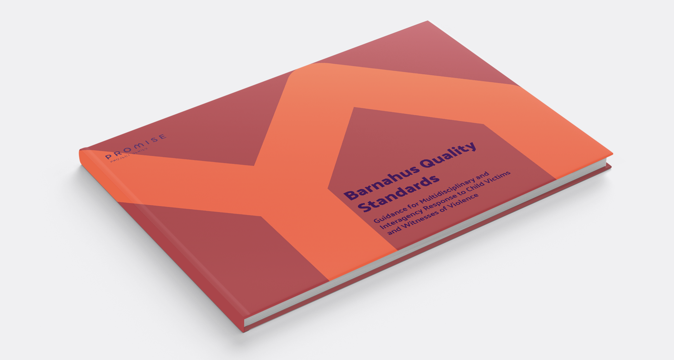The Barnahus Quality Standards
The standards are composed of underlying principles, specific activities and institutional arrangements that enable child-centred and effective, collaborative actions.

The Barnahus Quality Standards
The standards are composed of underlying principles, specific activities and institutional arrangements that enable child-centred and effective, collaborative actions.
The 10 Barnahus Quality Standards
Standard 1: Key principles and cross-cutting activities
- Children and their non-offending family/care-givers/support persons have access to adequate information all times.
- Children and their non-offending family/care-givers/support persons can influence the timing, location and set up of the interventions in the service.
- Children are given opportunities to express themselves and their views, needs and concerns inform best interests assessments and interventions
- Measures are taken to avoid undue delay:
- Ensuring that forensic interviews take place within a stipulated time period;
- Ensuring that child protection assessments take place within a stipulated time period;
- Ensuring that children benefit from timely medical and mental health assessment;
- Ensuring that interventions both for the child and child’s family/care-givers/support persons can be started as soon as possible.
Standard 2: Multidisciplinary and interagency collaboration
- A formal interagency agreement, including a clear definition of the agencies’ respective roles and responsibilities has been signed by authorized representatives, committing the services to multi-disciplinary and interagency collaboration in the service.
- The service is recognised and regulated by a national or local social or child protection services, law enforcement/judicial system or the national health system through law or formal agreement.
Standard 3: Inclusive target group
- All children who are victims and/or witnesses of violence regardless the form of violence have equal access to the service and are offered a multi-disciplinary response.
- Special effort is made to reach all child victims and witnesses regardless of form of violence.
Standard 4: Child friendly environment
- The location is set up in a safe, child-friendly and age-appropriate way, considering:
- furnishing of the waiting- and interview room
- materials (for example age-appropriate toys, reading and activities)
- private and soundproof rooms
- Contact between victim and alleged offender is avoided at all times.
- The services are (physically) accessible to all children regardless of place of residence, (this includes children with disabilities and/or special needs).
Standard 5: Interagency case management
- The interagency team and the respective agencies share information relevant about the case throughout the criminal investigation and judicial process as appropriate for the benefit and in the best interest of the child.
- A designated professional of the team monitors and coordinates the multi-disciplinary response, including interagency case assessments. Interagency case assessments form the basis for individual plans for each child.
- The service ensures continuous documentation and access to relevant case information to the interagency team members on the progress of the case until case closure.
- The privacy of the child is guaranteed. There is a clear plan for dealing with the confidential information from the clients, the storage of this information and who has access to it.
Standard 6: Forensic interview
To ensure the quality of the obtained evidence and to minimize the influence of the interviewer:
- Forensic interviews are carried out by specialized staff members.
- Forensic interviews are carried out according to evidence-based practice and protocols.
- The forensic interview is adapted to the child’s specific background characteristics (for example: age, development, cultural background, and takes special needs into account).
Standard 7: Medical examination
- Medical examinations and treatment are routinely carried out on the premises of the MD/IA service (unless urgent or complicated cases require special interventions or equipment at a hospital setting, as an outpatient or inpatient).
- Medical assessments in MD/IA setting are, as far as possible, carried out at the same day as the forensic interview.
- The medical examination is carried out by specialized staff who are trained on recognizing indicators of physical, sexual, and emotional abuse as well as child neglect.
Standard 8: Therapeutic services
- Mental health services and treatment are provided by professionals with specialized training and expertise.
- Mental health assessment and treatment is routinely made available for child victims and witnesses that are referred to the service.
- Interventions both for the child and child’s family/care-givers/support persons start as soon as possible.
Standard 9: Capacity building
- Staff receive regular team and individual training.
- Staff is offered peer support and supervision
- The staff regularly develops its competences and has access to education in different ways: guidance, counselling, supervision, study visits, information meetings, lectures.
- The progress is tracked: there is a clear system for evaluating and reviewing the service.
Standard 10: Prevention: information sharing, awareness raising and external competence building
- External competence building: The service offers targeted action to increase competence and knowledge among professionals working for and with children, by for example organising study visits, information meetings, lectures and producing written material
- The service contributes to data collection and information sharing: Aggregated and disaggregated data/statistics is collected and shared with relevant stakeholders, including decision-makers, academia, child protection professionals, and the broader public.
Note: Violence against children is here defined according to article 19 of the UN Convention on the Rights of the Child: “all forms of physical or mental violence, injury and abuse, neglect or negligent treatment, maltreatment or exploitation, including sexual abuse”.
The text of this specific page is available for modification and reuse under the terms of the Creative Commons Attribution-Sharealike 3.0 Unported License and the GNU Free Documentation License (unversioned, with no invariant sections, front-cover texts, or back-cover texts).
Also available in your language
The Standards are currently being translated into new languages. All language versions will be published here.
Would you like to translate the standards into your own national language? Please contact us to find out more about format, attribution and copyright.
